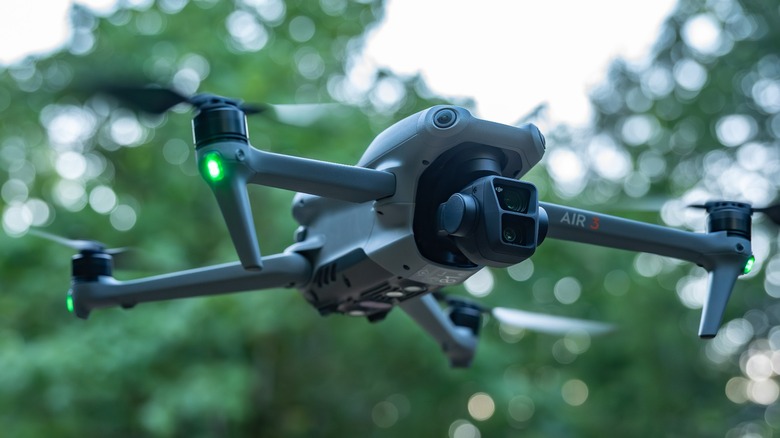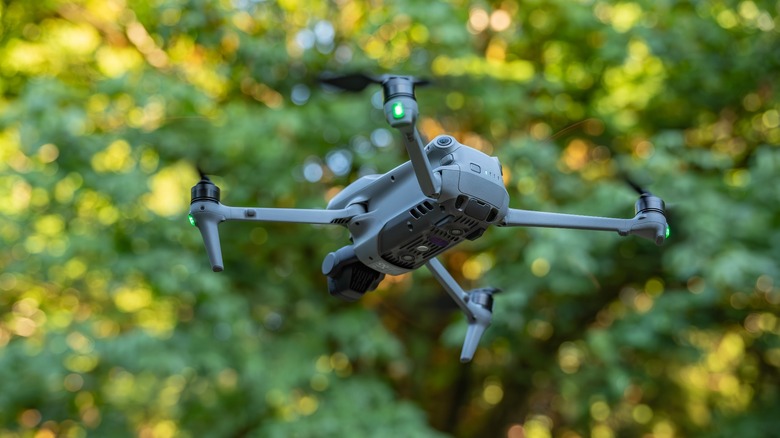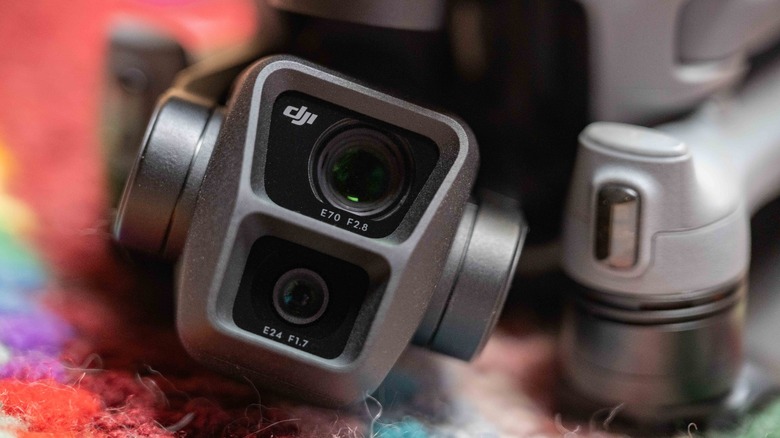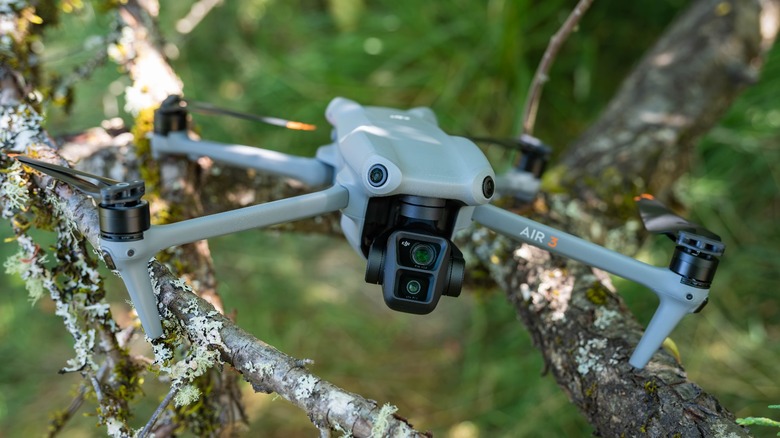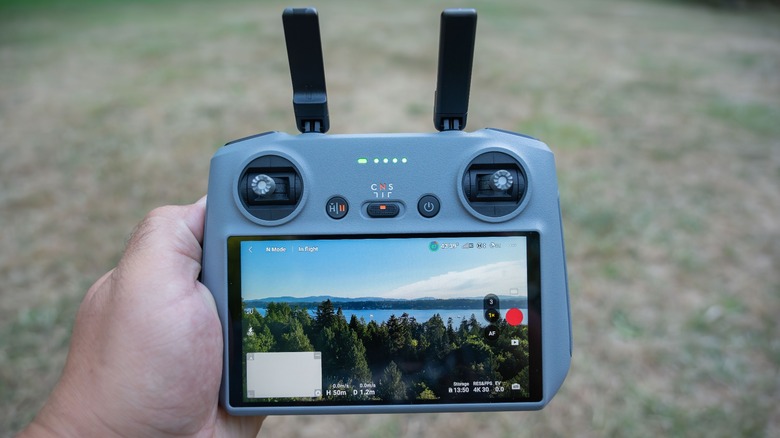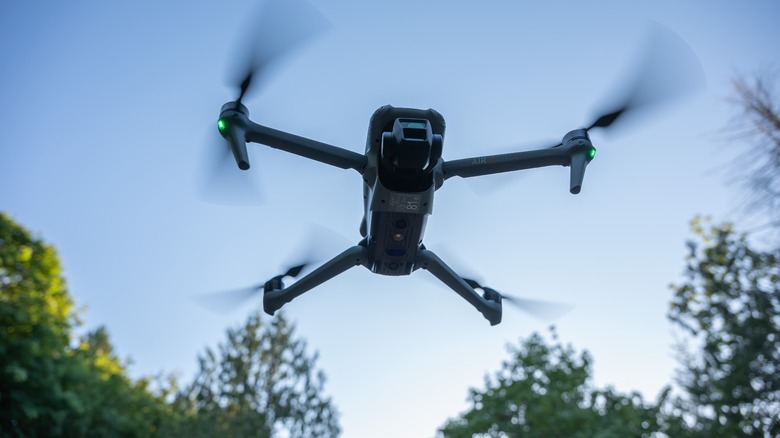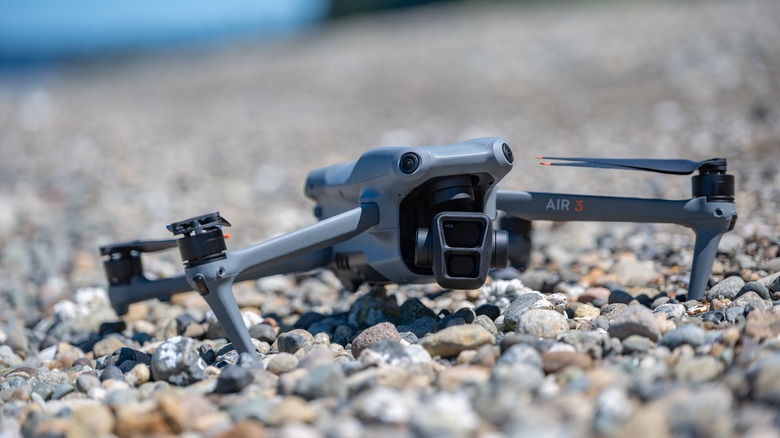DJI Air 3 Review: High-End Features In A Mid-Range Drone
- 3x telephoto camera adds flexibility
- Good image quality from both cameras
- Waypoint functionality
- Relatively quiet
- Good value
- Occusync 4 image transmission
- 46 minute battery life
- Smaller sensor than the DJI Air 2S
- Gimbal cover is a step backwards
The DJI Air 3 rounds out DJI's already impressive lineup, and is designed to fill a noticeable void previously occupied by the aging DJI Air 2S. On paper, the DJI Air 3 comes with only a few meaningful compromises compared to more expensive drones and offers big upgrades over the Mini 3 Pro. Headlining features include nearly an hour of purported battery time, two high-resolution cameras, waypoint functionality, and an upgraded transmission system.
Among DJI drones, the Air series has always offered an attractive value to drone pilots who don't want to spring for the top-end models, or who prefer a slightly smaller and more portable device. The question is whether or not this latest drone lives up to its impressive legacy, if you should upgrade, or if you should consider one of DJI's other drones.
DJI provided a sample of the Air 3 for the purposes of this review.
Medium sized masterpiece
DJI seems to have found the ideal shape for a camera drone, which might lead one to feel that all their new drones look the same. However, it would be better to characterize this as a case of not fixing that which isn't broken. The folding arms allow them to be easy to carry, while also delivering impressive performance. The location of the camera gimbal protects the delicate optics while also allowing a wide range of motion. At this point, DJI drone design has been fully refined, and advancements are now focused on improving capabilities.
The Air 3 sits between the tiny, ultralight DJI Mini 3 Pro and the larger DJI Mavic 3 Pro, providing a good compromise in terms of size, features, and performance. The most notable design change is that the USB and MicroSD card slots are now located below the battery, rather than above.
Perhaps our biggest complaint about the Air 3 is the gimbal cover, which disappointingly is a major step down from the system in place on the Mavic 3 series. Those feature a large harness that protects both the gimbal and the motors. The Air 3 uses an older design, just a plastic snap-on hood which is somewhat difficult to attach. We would very much like for this design of gimbal protector to be phased out of drones, regardless of price point.
Two cameras are better than one
The Air 3 has a dual camera system that bears a striking resemblance to the Mavic 3 Pro, and this similarity is more than skin deep. The 3x telephoto camera of the Air 3 appears to be practically identical to that found in the much more expensive Mavic 3 Pro. Both cameras on the Air have 48 megapixels, with the wide angle featuring an f/1.7 aperture and the telephoto featuring a slightly darker f/2.8 aperture.
Interestingly, the wide-angle camera appears to be the same as is utilized in the Mini 3 Pro, making the camera system something of a hybrid between the Mini 3 Pro and the Mavic 3 Pro. Compared to the Air 2S, while that drone's sensor is indeed larger, the Air 3 features a new stacked sensor, and this newer tech practically negates the image quality gap between the two.
Having two different focal lengths on a drone is extremely useful, as it allows you to capture multiple unique shots of a scene for creative filmmaking. It also helps you film locations from a distance when you don't have the option to fly up close.
Great image quality
While sensor size is a limitation of both cameras on the Air 3, the drone is nonetheless capable of capturing excellent image quality. The 48 megapixels don't quite translate into the same sort of post-processing crop capability you'd find in a 48-megapixel camera with a larger sensor, but thanks to the 3x telephoto camera you won't often feel the need to crop after the fact. When the sun was in the frame we did see some pretty significant flaring, but nothing more than we expected, and sometimes such flaring can create a compelling effect in a video when handled correctly.
While traditional photo modes are available, the DJI Air 3 uses SmartPhoto 3.0 as its default still photo mode. This is an automated mode that attempts to choose the right settings for what it's shooting and produces HDR DNG format files. This strikes a nice balance between the high degree of post-processing capability from regular DNG files, and the ease of post-production associated with JPEG images.
In terms of video abilities, the Air 3 is remarkably capable. Both cameras can shoot 4K 60fps HDR video, 4K 100fps slow motion, 1080p at up to 200fps, and the drone has a unique 2.7k 60fps vertical shooting mode. In this mode both cameras film simultaneously to produce a 2.7k video which can be quickly and easily shared on social media, as well as a traditional landscape video.
Punching above its weight
The Air 3 may be smaller and cheaper than the Mavic 3, but it's no less capable. In some ways, it actually features newer tech than even the flagship Mavic 3 Pro. This is in reference to the Air 3 featuring DJI's Occusync 4 transmission system which has a massive 20km range and improved stability, as well as a 1080p 60fps live feed to the controller.
The Air 3 features the same Omnidirectional obstacle sensing system and APAS 5.0 capability to keep you out of trouble. You should always be cautious while flying of course; these features aren't infallible, and they are disabled entirely when flying in Sport mode. However, they do provide a nice safety net, which is particularly useful to novice pilots.
As for battery life, the Air 3 can stay in the air for up to 46 minutes, which goes toe to toe with the Mavic 3 Classic and even beats the Mavic 3 Pro. That means with a couple of extra batteries you can do an awful lot of aerial filming before needing to recharge, plus with an 81-decibel noise rating, the Air 3 is one of the quietest drones around.
A familiar app
On the software front, the DJI Fly app offers the same experience you'd get flying most other current DJI drones. It's what you'll use to pilot the drone on either your phone or tablet or on the DJI RC 2. Swapping between lenses, adjusting settings, or activating various features is intuitive and easy to do on the fly.
The usual automated videography and photography modes are present here with Quickshots and Mastershots, allowing you to pull off maneuvers that would otherwise take a lot of practice to learn. A key upgrade to consider here is waypoint mode, where the drone will automatically fly on a predetermined route so that you can save and repeat shots at later points in time. Examples of use cases for this include capturing locations in different seasons or at different times of day, which can make for really beautiful transitions. Night mode and hyperlapse modes complement waypoint flight, and overall the Air 3 offers an expansive range of exciting features.
Also on the software front, it's worth noting that the Air 3 supports QuickTransfer to move files directly from the drone to your phone, and LightCut, which is a useful mobile piece of video editing software.
New controllers and ND filters
The Air 3 brings with the launch of a new generation of controllers, which are familiar to long-time DJI pilots, but also bring some significant improvements. These new controllers are key to the Air 3's introduction of Occusync 4, and all the benefits which come with that. While we didn't have the opportunity to test the new DJI RC-N2, which is the basic controller which requires a phone or tablet to use, we did fly the Air 3 with the new DJI RC 2 controller with its built-in screen. The screen is brighter than the one found in the previous DJI RC controller, and the controls have been improved.
Also available are a couple of different chargers, including a 100W USB-C power adapter, which is a particularly fast way of charging both your batteries and controller at the same time. An ND filter set is available. This is a useful, perhaps essential tool for aerial filmmaking, as it helps you achieve a desired frame rate in bright conditions. The available set for the Air 3 is good, and it's easy to exchange filters. However, unlike the filter set for the Mavic 3 Pro, the ND32 and ND64 filters introduce a significant color cast to images and video.
Pro features at an affordable price
While its base price will set you back $1099, that's not bad considering how complete the feature set of the Air 3 is. The major sacrifice compared to the $1599 DJI Mavic 3 Classic is that the Mavic 3 Classic features a huge Miro 4/3 size sensor. That's certainly worth an extra $500, as the image quality from that drone is a significant step up. However, the Air 3 is no slouch in the imaging department, and if you want a secondary telephoto lens you'll need to step all the way up to the triple camera array of the DJI Mavic 3 Pro which starts at $2199. Alternatively, to save some money, the DJI Mini 3 Pro is highly competitive in many respects with the DJI Air 3 and costs just $669.
Of course, it's also necessary to consider the cost of accessories you may want. Typically, one battery isn't enough, so one of the optional Fly More combos may be attractive, and we would recommend it to most people, as they offer a discount on accessories you are likely to end up purchasing anyway. While it's natural to balk at the $1549 price tag of the Fly More combo with the DJI RC 2 which we tested, having a remote with a built-in screen is far superior to having to use a phone or a tablet to control a drone.
Overall, the Air 3 is a decent value for the money.
Conclusion
The DJI Air 3 truly hits the sweet spot in terms of features, performance, and price. For those who don't need the high end Hasselblad camera of the DJI Mavic 3 Pro and Classic, the Air 3 manages to do just about everything else those drones are capable of for much less money. While it would have been nice to see a 1-inch sensor in the Air 3, the smaller sensor is at least able to keep up with its predecessor's larger sensor, thanks to the newer tech in the Air 3. The twin camera system of the Air 3 produces fantastic results, so it's hard to really complain about the sensor size. A bigger gripe is the cheap and awkward gimbal cover, and it would be nice if DJI would at least sell a replacement gimbal cover similar to that of the Mavic 3.
In the end however, the fact that I am singling out the protective gimbal cover as my main downside to this drone is a testament to just how excellent and well-rounded the DJI Air 3 is. It fits perfectly as a mid-range option in DJI's lineup, and is an easy drone to recommend.
